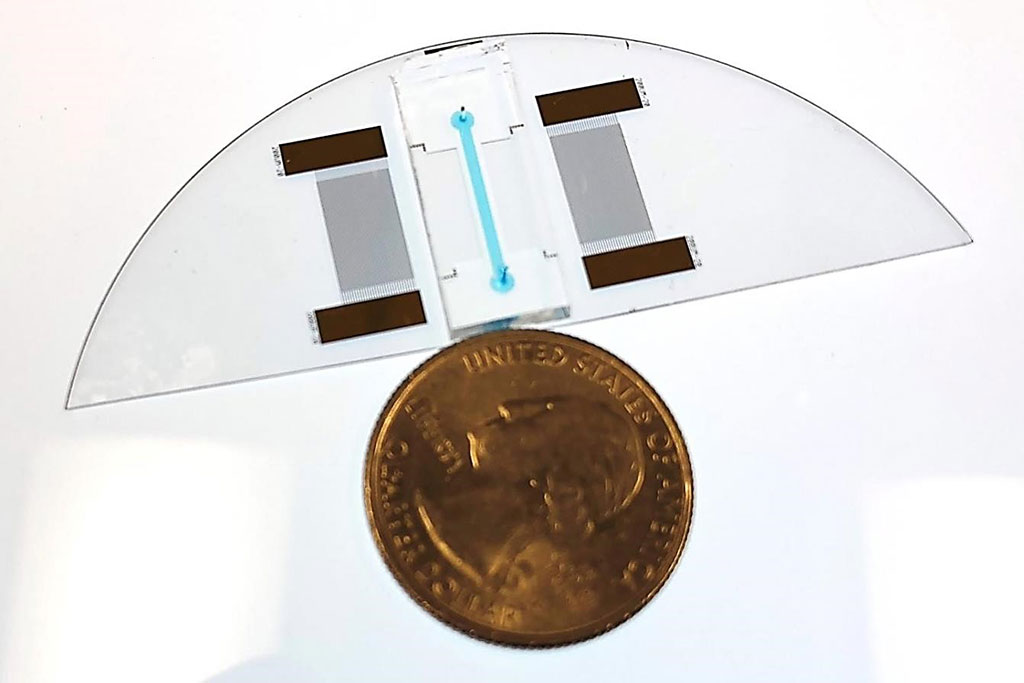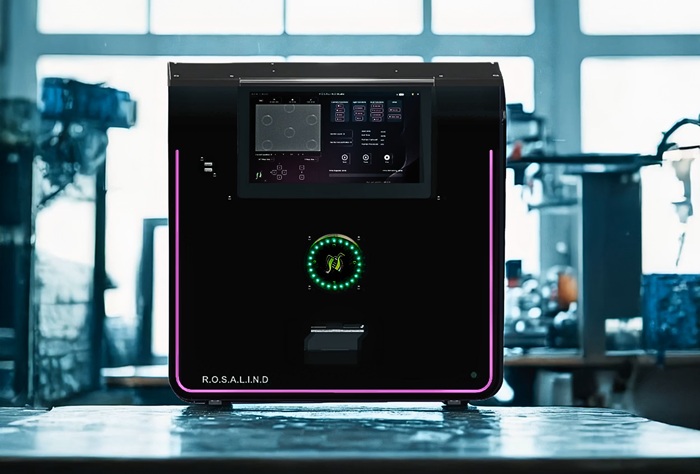New Technology Rapidly Diagnoses Sickle Cell Disease
|
By LabMedica International staff writers Posted on 29 Oct 2020 |

Image: An Acousto Thermal Shift Assay `lab-on-a-chip` device shown next to a US quarter for size comparison. The device can diagnose sickle cell anemia (Photo courtesy of CU Boulder College of Engineering and Applied Science).
Sickle cell disease (SCD) is a group of blood disorders typically inherited from a person's parents. The most common type is known as sickle cell anemia (SCA). It results in an abnormality in the oxygen-carrying protein hemoglobin found in red blood cells.
Sickle cell disease occurs when a person inherits two abnormal copies of the β-globin gene that makes hemoglobin, one from each parent. This gene occurs in chromosome 11. Several subtypes exist, depending on the exact mutation in each hemoglobin gene. An attack can be set off by temperature changes, stress, dehydration, and high altitude.
Molecular, Cellular and Developmental Biologists at the University of Colorado, (Boulder, CO, USA) have developed a new way to diagnose diseases of the blood like sickle cell disease with sensitivity and precision and in only one minute. Their technology is smaller than a quarter and requires only a small droplet of blood to assess protein interactions, dysfunction or mutations. The team used Thermal Shift Assays (TSAs) to assess protein stability under varying conditions. Such tests took about a day to run. Now, with the new technology, an Acousto Thermal Shift Assay (ATSA), they can do the same but faster and with greater sensitivity.
Proteins have a specific solubility at a specific temperature. The solubility changes when one protein bonds to another, or when the protein is mutated, by measuring solubility at different temperatures, scientists can tell whether the protein has been mutating. The ATSA utilizes high-amplitude sound waves, or ultrasound, to heat a protein sample. The tool then measures data continuously, recording how much of the protein has dissolved at every fraction of change in degrees Celsius. The ATSA requires only a power source, a microscope and a camera as simple as the one on a smartphone. Because the protein is concentrated, there is also no need to apply a florescent dye as is sometimes required to highlight protein changes in a traditional TSA.
Yonghui Ding, PhD, a post-doctoral fellow and the first author of the study, said, “The method is seven to 34 times more sensitive. The ATSA can distinguish the sickle cell protein from normal protein, while the traditional TSA method cannot.” The study was published on October 15, 2020 in the journal Small.
Related Links:
University of Colorado
Sickle cell disease occurs when a person inherits two abnormal copies of the β-globin gene that makes hemoglobin, one from each parent. This gene occurs in chromosome 11. Several subtypes exist, depending on the exact mutation in each hemoglobin gene. An attack can be set off by temperature changes, stress, dehydration, and high altitude.
Molecular, Cellular and Developmental Biologists at the University of Colorado, (Boulder, CO, USA) have developed a new way to diagnose diseases of the blood like sickle cell disease with sensitivity and precision and in only one minute. Their technology is smaller than a quarter and requires only a small droplet of blood to assess protein interactions, dysfunction or mutations. The team used Thermal Shift Assays (TSAs) to assess protein stability under varying conditions. Such tests took about a day to run. Now, with the new technology, an Acousto Thermal Shift Assay (ATSA), they can do the same but faster and with greater sensitivity.
Proteins have a specific solubility at a specific temperature. The solubility changes when one protein bonds to another, or when the protein is mutated, by measuring solubility at different temperatures, scientists can tell whether the protein has been mutating. The ATSA utilizes high-amplitude sound waves, or ultrasound, to heat a protein sample. The tool then measures data continuously, recording how much of the protein has dissolved at every fraction of change in degrees Celsius. The ATSA requires only a power source, a microscope and a camera as simple as the one on a smartphone. Because the protein is concentrated, there is also no need to apply a florescent dye as is sometimes required to highlight protein changes in a traditional TSA.
Yonghui Ding, PhD, a post-doctoral fellow and the first author of the study, said, “The method is seven to 34 times more sensitive. The ATSA can distinguish the sickle cell protein from normal protein, while the traditional TSA method cannot.” The study was published on October 15, 2020 in the journal Small.
Related Links:
University of Colorado
Latest Technology News
- Diagnostic Chip Monitors Chemotherapy Effectiveness for Brain Cancer
- Machine Learning Models Diagnose ALS Earlier Through Blood Biomarkers
- Artificial Intelligence Model Could Accelerate Rare Disease Diagnosis
- AI Saliva Sensor Enables Early Detection of Head and Neck Cancer
- AI-Powered Biosensor Technology to Enable Breath Test for Lung Cancer Detection
- AI Model Achieves Breakthrough Accuracy in Ovarian Cancer Detection
- Portable Biosensor Diagnoses Psychiatric Disorders Using Saliva Samples
- Cell-Sorting Device Uses Electromagnetic Levitation to Precisely Direct Cell Movement

- Embedded GPU Platform Enables Rapid Blood Profiling for POC Diagnostics
- Viral Biosensor Test Simultaneously Detects Hepatitis and HIV
Channels
Clinical Chemistry
view channel
Noninvasive Blood-Glucose Monitoring to Replace Finger Pricks for Diabetics
People with diabetes often need to measure their blood glucose multiple times a day, most commonly through finger-prick blood tests or implanted sensors. These methods can be painful, inconvenient, and... Read more
POC Breath Diagnostic System to Detect Pneumonia-Causing Pathogens
Pseudomonas aeruginosa is a major cause of hospital-acquired and ventilator-associated pneumonia, particularly in lung transplant recipients and patients with structural lung disease. Its ability to form... Read moreMolecular Diagnostics
view channel
World's First NGS-Based Diagnostic Platform Fully Automates Sample-To-Result Process Within Single Device
Rapid point-of-need diagnostics are of critical need, especially in the areas of infectious disease and cancer testing and monitoring. Now, a direct-from-specimen platform that performs genomic analysis... Read more
Rapid Diagnostic Breakthrough Simultaneously Detects Resistance and Virulence in Klebsiella Pneumoniae
Antibiotic resistance is a steadily escalating threat to global healthcare, making common infections harder to treat and increasing the risk of severe complications. One of the most concerning pathogens... Read moreImmunology
view channel
Blood Test Could Identify Colon Cancer Patients to Benefit from NSAIDs
Colon cancer remains a major cause of cancer-related illness, with many patients facing relapse even after surgery and chemotherapy. Up to 40% of people with stage III disease experience recurrence, highlighting... Read moreBlood Test Could Detect Adverse Immunotherapy Effects
Immune checkpoint inhibitors have transformed cancer treatment, but they can also trigger serious immune-related adverse events that damage healthy organs and may become life-threatening if not detected early.... Read moreMicrobiology
view channel
New UTI Diagnosis Method Delivers Antibiotic Resistance Results 24 Hours Earlier
Urinary tract infections affect around 152 million people every year, making them one of the most common bacterial infections worldwide. In routine medical practice, diagnosis often relies on rapid urine... Read more
Breakthroughs in Microbial Analysis to Enhance Disease Prediction
Microorganisms shape human health, ecosystems, and the planet’s climate, yet identifying them and understanding how they are related remains a major scientific challenge. Even with modern DNA sequencing,... Read morePathology
view channel
AI Tool Simultaneously Identifies Genetic Mutations and Disease Type
Interpreting genetic test results remains a major challenge in modern medicine, particularly for rare and complex diseases. While existing tools can indicate whether a genetic mutation is harmful, they... Read more
Rapid Low-Cost Tests Can Prevent Child Deaths from Contaminated Medicinal Syrups
Medicinal syrups contaminated with toxic chemicals have caused the deaths of hundreds of children worldwide, exposing a critical gap in how these products are tested before reaching patients.... Read more
Tumor Signals in Saliva and Blood Enable Non-Invasive Monitoring of Head and Neck Cancer
Head and neck cancers are among the most aggressive malignancies worldwide, with nearly 900,000 new cases diagnosed each year. Monitoring these cancers for recurrence or relapse typically relies on tissue... Read moreTechnology
view channel
Diagnostic Chip Monitors Chemotherapy Effectiveness for Brain Cancer
Glioblastoma is one of the most aggressive and fatal brain cancers, with most patients surviving less than two years after diagnosis. Treatment is particularly challenging because the tumor infiltrates... Read more
Machine Learning Models Diagnose ALS Earlier Through Blood Biomarkers
Amyotrophic lateral sclerosis (ALS) is a rapidly progressive neurodegenerative disease that is notoriously difficult to diagnose in its early stages. Early symptoms often overlap with other neurological... Read moreIndustry
view channel
BD and Penn Institute Collaborate to Advance Immunotherapy through Flow Cytometry
BD (Becton, Dickinson and Company, Franklin Lakes, NJ, USA) has entered into a strategic collaboration with the Institute for Immunology and Immune Health (I3H, Philadelphia, PA, USA) at the University... Read more




 assay.jpg)



















